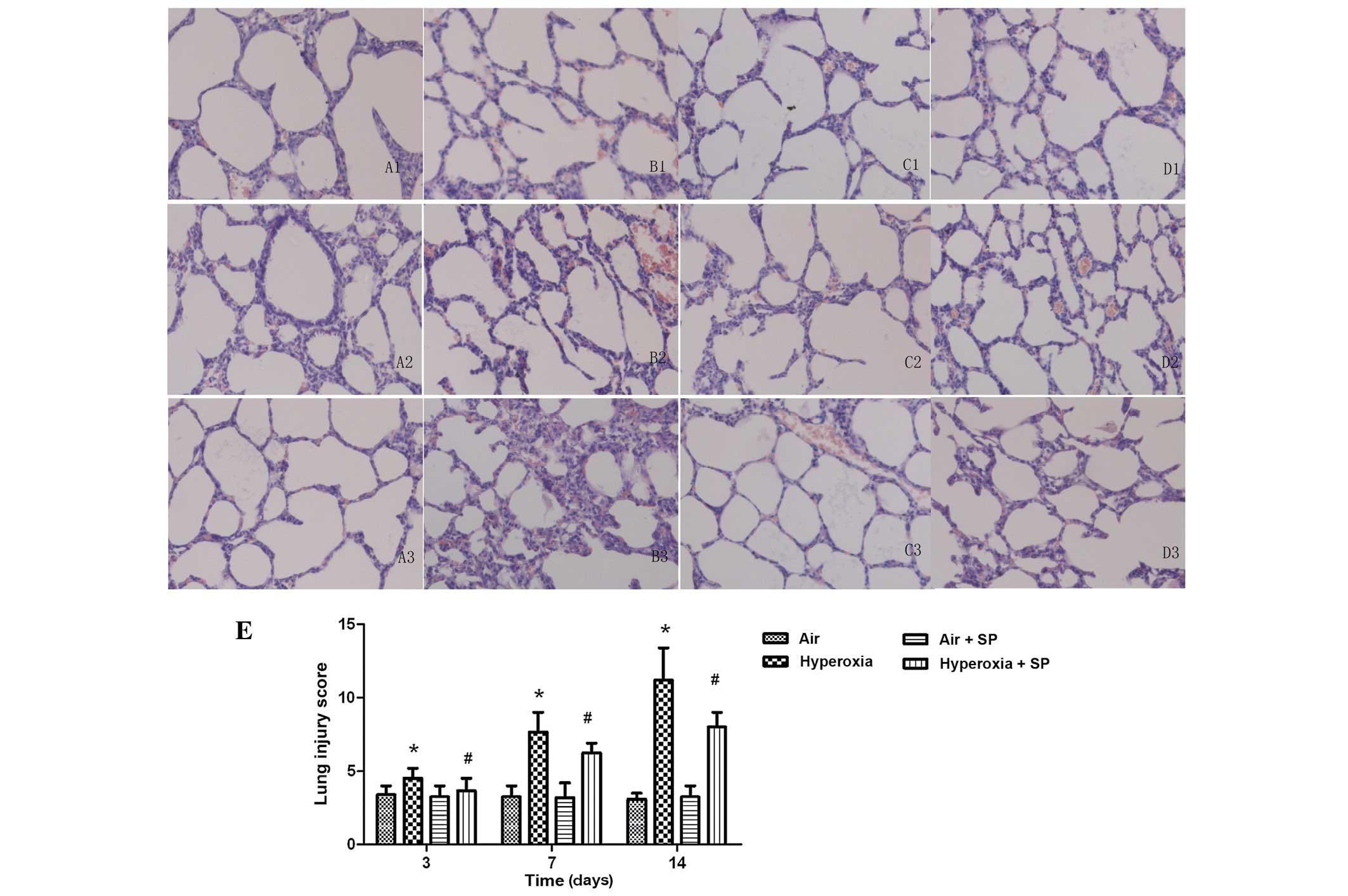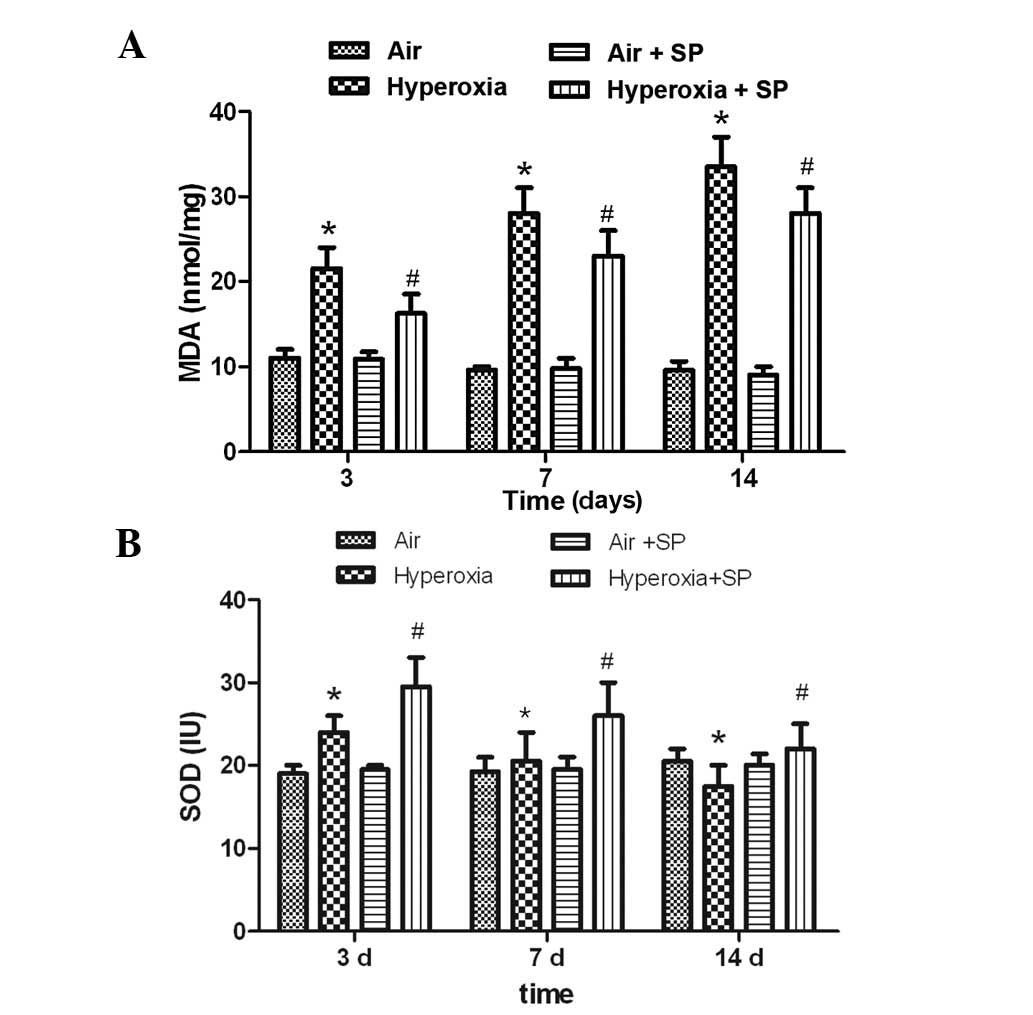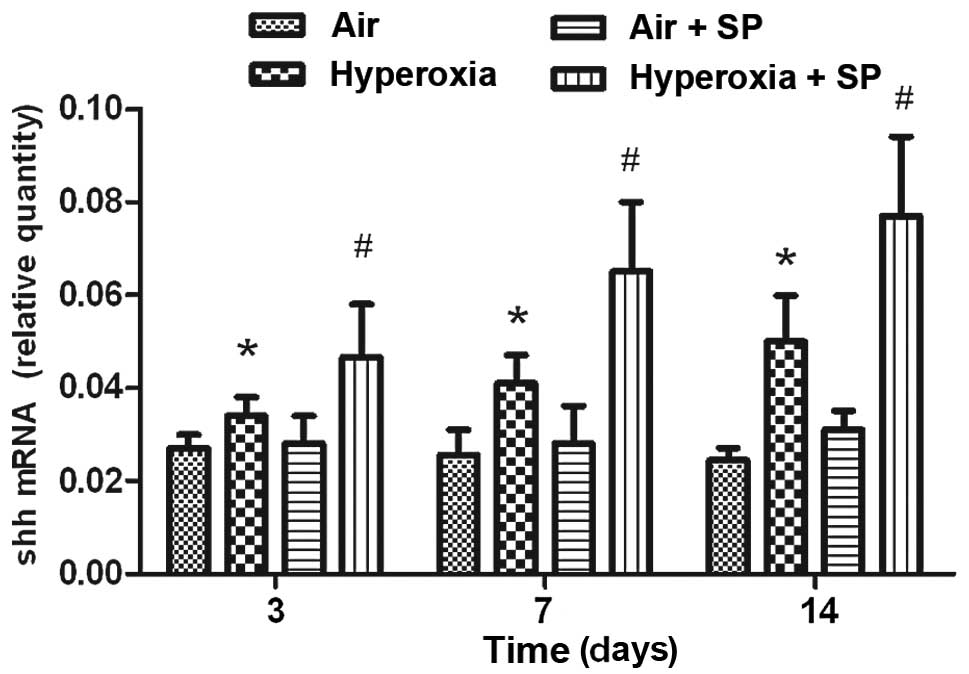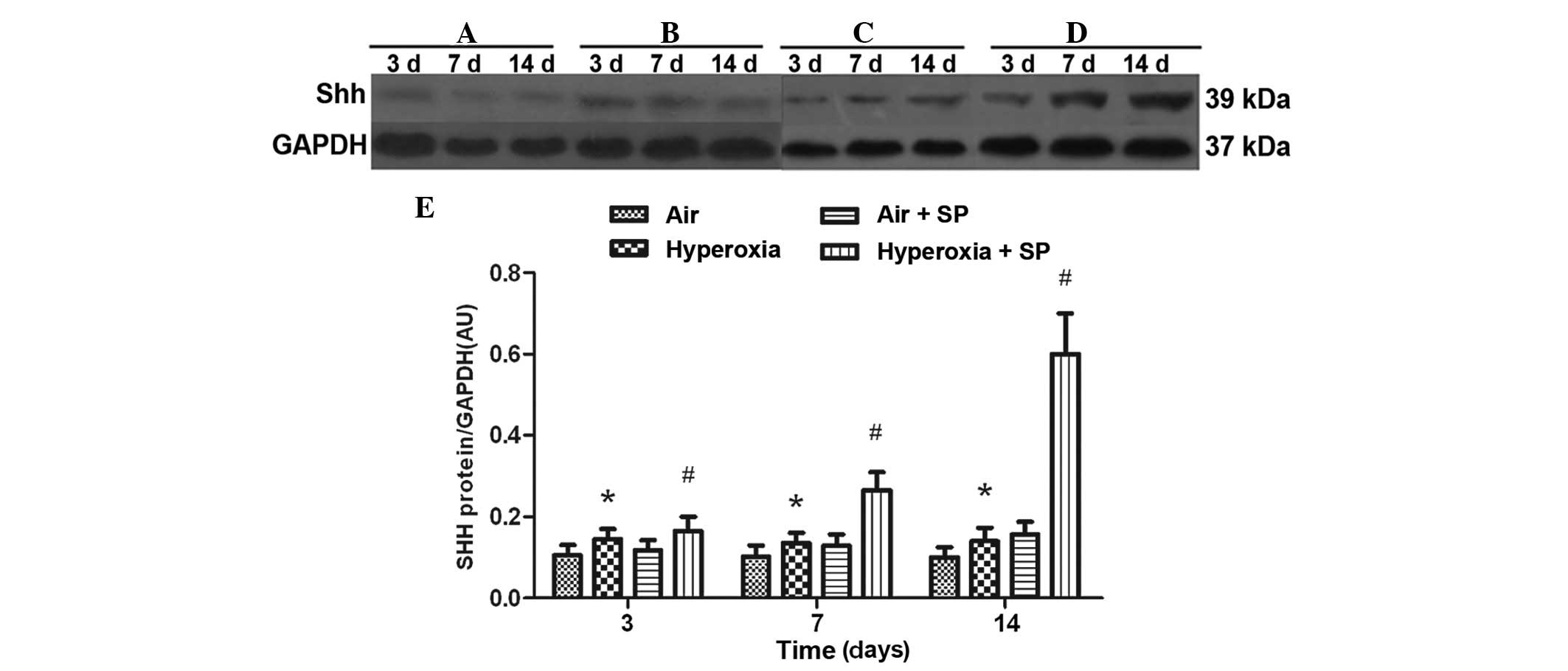Substance P attenuates hyperoxia‑induced lung injury in neonatal rats
- Authors:
- Published online on: November 18, 2013 https://doi.org/10.3892/mmr.2013.1809
- Pages: 595-599
Abstract
Introduction
Hyperoxia exposure is a common therapeutic strategy for patients with severe pulmonary diseases. However, prolonged exposure to high concentrations of oxygen often causes acute and chronic lung injury due to oxygen toxicity. Clinical studies (1) have shown that hyperoxia exposure is a significant risk factor for acute lung injury (ALI) and bronchopulmonary dysplasia (BPD). Oxygen toxicity is hypothesized to be mediated by the production and accumulation of excessive reactive oxygen species (ROS), at levels exceeding the capacity of the lung antioxidant defense mechanisms (2), leading to cell damage and death. Therefore, inhibiting the oxygen toxicity or improving the survival of epithelial cells may be a method of preventing hyperoxia lung injury.
Hyperoxia exposure also stimulates C fibers and C fiber activation induces the release of neuropeptide substance P (SP) (3). SP binds primarily to NK-1 receptors (NK-1R) (4) and plays a role in regulating airway blood flow, airway smooth muscle responses, airway inflammation and epithelial migration and cell proliferation, including tracheal epithelial cells, following injury (5,6). A previous in vitro study showed that SP may attenuate hyperoxia-induced oxidative stress injury, promote type II alveolar epithelial cell (AECII) proliferation and inhibit apoptosis (7). However, whether SP is involved in or has a positive effect in hyperoxia lung injury in vivo has not been reported. The signaling mechanism underlying the protective effect of SP against hyperoxia is poorly understood.
Previous studies demonstrated that sonic hedgehog (SHH) plays a critical role in lung morphogenesis and lung organogenesis (8,9). SHH regulates cell proliferation, differentiation and migration in vitro and in vivo (10–12). Therefore, the SHH signal transduction pathways are hypothesized to play a role in the regulatory mechanism of SP in hyperoxia-induced neonatal lung injury. The aim of the current study was to investigate the effect of SP on neonatal rat exposure to hyperoxia and to demonstrate the related regulatory mechanism of SP.
Materials and methods
Experimental animals
Timed-pregnant specific-pathogen-free Sprague-Dawley rats were obtained from the Experimental Animal Center of Chongqing Medical University (Chongqing, China). The experiments were conducted in accordance with the National Guidelines for the Care and Use of Laboratory Animals. The experiment was approved by the Ethics Committee of Chongqing Medical University.
Materials
SP was provided by Abcam (Cambridge, MA, USA). Malondialdehyde (MDA), superoxide dismutase (SOD) assay and DAB kits were provided by Kaiji Biological Company (Nanjing, China). SHH polyclonal antibody was purchased from Abbiotec (San Diego, CA, USA). RT and PCR kits and SYBR-Green I were provided by Shanghai ShineGene Molecular Biotechnology Co., Ltd. (Shanghai, China).
Establishment of animal oxidative model
The rats were housed in individual cages with free access to water and laboratory chow and the rat pups were delivered spontaneously. Neonatal rats were nested on softwood shavings and distributed to litters of ten of equal body weight in Plexiglas chambers. The chambers were equipped with a flow through system for controlling the delivery of medical oxygen or room air.
Twelve-hour-old neonatal rats were randomly divided into one of four groups: air, hyperoxia, air + SP and hyperoxia + SP. Rats from the air and air + SP groups were exposed to air and maintained O2 levels >21%, while the rats in hyperoxia and hyperoxia + SP groups were placed in a sealed Plexiglas chamber with a minimal in-and-outflow, providing 4–5 exchanges/h of chamber volume and maintaining O2 levels >95% simultaneously. Exposure to hyperoxia was continuous, with brief interruptions only for animal care (30 min/day). The concentration of oxygen was maintained by the use of an oxygen controller. The rats in the air + SP group and hyperoxia + SP group received intraperitoneal injections of rat SP (5 μg/kg, qod). The rats in the air and air + SP groups received intraperitoneal injections of saline vehicle alone at the same time point.
Tissue preparation
The rat pups were sacrificed at days 3, 7 and 14 of hyperoxia exposure, and ~5 animals at different times in each group were used in the study. Under deep pentobarbital anesthesia (50 mg/kg, intraperitoneal injection), a midline incision was made through the sternum and abdomen, then the whole-lung tissue was obtained.
Histopathology
Following sacrifice, the left lungs were excised and fixed by overnight immersion in 4% paraformaldehyde in phosphate-buffered saline at 4°C. The specimens were dehydrated in a graded ethanol series. Tissues were embedded in paraffin, sectioned and stained with hematoxylin and eosin (H&E).
Oxidation and antioxidation assay
To determine the damage caused by oxygen, the activities of MDA and endogenous antioxidant enzymes SOD were measured according to the manufacturer’s instructions.
Quantitative polymerase chain reaction (qPCR)
qPCR was performed using the SYBR-Green real-time PCR method. Total RNA was extracted from lung tissue. qRT-PCR was performed on an FTC2000 PCR instrument (Funglyn Biotech Inc., Toronto, ON, Canada) using the two-stage program parameters provided by the manufacturer, as follows: 4 min at 94°C, 35 cycles of 20 sec at 94°C and 30 sec at 60°C and 30 sec at 70°C. Specificity of the produced amplification product was confirmed by the examination of dissociation reaction plots. A distinct single peak indicated that a single DNA sequence was amplified during PCR. PCR products were run on 2% agarose gels to confirm that the correct molecular sizes were presented. Each sample was tested in triplicate and samples obtained from three independent experiments were used for the analysis of relative gene expression using the 2−ΔΔCt method. The primers used for qPCR were: glyceraldehyde-3-phosphate dehydrogenase (GAPDH): Amp forward, 5′-CCCATCTATGA GGGTTACGC-3′ and reverse, 5′-TTTAATGTCACGCACGA TTTC-3′; and for SHH: Amp forward, 5′-TCGTGCTACGC AGTCATCG-3′ and reverse, 5′-CGCTTCCGCTACAGAT TGC-3′.
Western blot analysis
Total tissue proteins were calculated using the BCA protein assay and proteins (50 μg) from each sample were loaded onto 10% SDS-polyacrylamide gels and electrophoretically transferred to polyvinylidene fluoride membranes. The membranes were blocked in 0.05% Tween-20/5% non-fat dried milk in TBST for 1 h, rinsed and incubated with the appropriate primary antibodies overnight at 4°C. After washing in TBST, the membranes were incubated with secondary antibody for 1.5 h at room temperature, followed by three washes in TBS. The immunoreactive proteins were visualized with peroxidase and an enhanced chemiluminescence system (ECL kit; Pierce Biotechnology, Rockford, IL, USA).
Statistical analysis
The data are expressed as means ± SEM. The statistical significance of the differences between the means of the groups was determined by one-way ANOVA or two-tailed Student’s t-tests. P<0.05 was considered to indicate a statistically significant difference.
Results
Lung histopathology
Results of H&E staining showed that, compared with the air group, the epithelial injury, inflammatory cell infiltrate, increased alveolar thickness and entrapped red blood cells, characteristic of hyperoxic injury, were present in the hyperoxia group at day 3 of hyperoxia exposure. The degree of these histopathological changes in the lung became more serious at 7 and 14 days. The lung pathological images in the hyperoxia + SP groups were improved significantly relative to the simple hyperoxia exposure. Improvement in pathological images had no significant difference between the air + SP and air groups. Representative photomicrographs showing differences in each experimental group are shown in Fig. 1.
MAD and SOD activity
To test the hypothesis that treatment of SP reduced systemic oxygen toxicity, the levels of MDA and SOD, indicators of oxidative stress damage and potent antioxidant properties, respectively, were measured. The results showed that the activities of MDA were significantly increased at 3, 7 and 14 days following hyperoxia exposure. SP may markedly inhibit the increase of MDA (Fig. 2A). The level of SOD were significantly increased at 3 days following hyperoxia exposure, but decreased at 14 days compared with the air group. Moreover, the levels of SOD were increased markedly at 3, 7 and 14 days following administration of rat SP (Fig. 2B).
mRNA expression of SHH
Hyperoxia stimulation rapidly induced the mRNA expression of SHH in lung tissue. Compared with air exposure, the mRNA expression level of SHH was increased at 3, 7 and 14 days following hyperoxia exposure (Fig. 3). SHH mRNA was expressed best at 14 days following hyperoxia exposure. Moreover, the mRNA expression level of SHH was further increased following additional SP treatment.
Protein expression of SHH
Compared with air exposure, hyperoxia stimulation rapidly induced the expression of SHH in lung tissue at 3, 7 and 14 days following the hyperoxia exposure. Furthermore, the protein expression of SHH was significantly increased following injection of SP, in a time-dependent manner. These data, in conjunction with the mRNA results, indicate that SP was involved in upregulating the SHH pathway in hyperoxia-induced lung injury (Fig. 4).
Discussion
Prolonged hyperoxia exposure is likely to cause direct oxidative damage through increased production of ROS. ROS may cause lipid peroxidation, oxidation of proteins and DNA damage, which induces cellular dysfunction and even cell death (13), resulting in hyperoxia lung injury (14). Hyperoxia lung injury is characterized by airway epithelial damage resulting from exposure to reactive oxygen products that overwhelm the lung’s endogenous supply of antioxidants.
A previous study suggested that hyperoxia may induce oxidative stress injury in a time-dependent manner in vitro (7). The present study has demonstrated that neonatal rats exposed to 95% oxygen may cause epithelial injury and inflammatory cell infiltration, characteristic of hyperoxia injury. Oxidative stress was shown to be elevated following hyperoxic exposure. Treatment with SP decreased MDA activities and increased SOD activities. In addition, in the present study, the pathological changes in lung tissue in hyperoxia + SP groups were improved significantly relative to the simple hyperoxia exposure, indicating that SP exerts antioxidant and protective effects in hyperoxia-induced lung injury.
SP is a low-molecular weight (~1 kDa) peptide, distributed widely in the airway endothelial cell layer, pulmonary vessels, the trachea, bronchus smooth muscle, bronchus ganglion and surrounding glands. Following release, SP binds primarily to NK-1R (4) and it was observed that SP triggers an exuberant neuroinflammatory response, regulates proliferation, migration and differentiation of the impaired cells (15,16). Dib et al (17) observed that sensory neurotransmitters exhibited significant protection for NK-1R-mediated functions in acute hyperoxic lung injury and the study provided positive evidence for NK-1R activation in acute hyperoxia. Oslund et al (18) observed that SP is an important mediator in airway epithelial cell death and subsequent proliferation following ozone exposure. The data suggested that the SP interference may be a protective strategy for hyperoxia-induced lung injury.
In addition to causing oxygen toxicity, previous studies have demonstrated that hyperoxia played a role in regulating SHH signal transduction pathways, including SHH, Patched 1 (PTCH1), smoothened (Smo) and GLI (19,20). SHH signaling protein is important in a number of processes, including embryogenesis, tissue repair, wound healing and lung morphogenesis (21–23). In the past few years, a large amount of information has emerged with regard to the mechanism and significance of SHH-PTCH-GLI signaling in lung morphogenesis (24,25).
SHH is known to be expressed at low levels in the normal lung and enhanced during the repair of damaged airway epithelium (26), but has not been studied under the normal and hyperoxia conditions in neonatal rats. In the current study, compared with air exposure, the expression level of SHH was markedly increased following hyperoxia exposure at different time points. This pathway was hypothesized to be activated in hyperoxia and may be a compensatory reflection to reduce hyperoxia-induced lung injury.
Whether or not activation of the SHH pathway is required for the protective effect of SP is yet to be determined. To highlight the effect of SP on SHH signal pathways, the mRNA and protein expression levels of SHH were determined. The current study also demonstrates that SHH pathway was activated by exogenous SP. Histopathology and an oxidation assay also supported the hypothesis that supplementary SP effectively improved lung pathological changes accompanied by upregulating the signaling pathway of SHH. This finding indicated that activation of SHH may be involved in the mechanism of SP protection of hyperoxia-induced injury.
It is hypothesized that SP interference, a protective management, produces a protective effect on neonatal rats against hyperoxia, which may be associated with attenuation of oxidative stress, elevation antioxidant activities and upregulation of the signaling pathway of SHH.
Acknowledgements
This study was supported by a grant from the National Natural Science Foundation of China (no. 30973218).
References
|
Kallet RH and Matthay MA: Hyperoxic acute lung injury. Respir Care. 58:123–141. 2013. View Article : Google Scholar | |
|
Buccellato LJ, Tso M, Akinci OI, Chandel NS and Budinger GR: Reactive oxygen species are required for hyperoxia-induced Bax activation and cell death in alveolar epithelial cells. J Biol Chem. 279:6753–6760. 2004. View Article : Google Scholar : PubMed/NCBI | |
|
Maggi CA, Giachetti A, Dey RD and Said SI: Neuropeptides as regulators of airway function: vasoactive intestinal peptide and the tachykinins. Physiol Rev. 75:277–322. 1995.PubMed/NCBI | |
|
Hökfelt T, Pernow B and Wahren J: Substance P: a pioneer amongst neuropeptides. J Intern Med. 249:27–40. 2001.PubMed/NCBI | |
|
Kim JS, Rabe KF, Magnussen H, Green JM and White SR: Migration and proliferation of guinea pig and human airway epithelial cells in response to tachykinins. Am J Physiol. 269:L119–L126. 1995.PubMed/NCBI | |
|
Kim JS, McKinnis VS, Adams K and White SR: Proliferation and repair of guinea pig tracheal epithelium after neuropeptide depletion and injury in vivo. Am J Physiol. 273:1235–1241. 1997.PubMed/NCBI | |
|
Huang B, Fu H, Yang M, Fang F, Kuang F and Xu F: Neuropeptide substance P attenuates hyperoxia-induced oxidative stress injury in type II alveolar epithelial cells via suppressing the activation of JNK pathway. Lung. 187:421–426. 2009. View Article : Google Scholar | |
|
Zhang M, Wang H, Teng H, Shi J and Zhang Y: Expression of SHH signaling pathway components in the developing human lung. Histochem Cell Biol. 134:327–335. 2010. View Article : Google Scholar : PubMed/NCBI | |
|
Li Y, Zhang H, Choi SC, Litingtung Y and Chiang C: Sonic hedgehog signaling regulates Gli3 processing, mesenchymal proliferation, and differentiation during mouse lung organogenesis. Dev Biol. 270:214–231. 2004. View Article : Google Scholar : PubMed/NCBI | |
|
Watkins DN, Berman DM, Burkholder SG, Wang B, Beachy PA and Baylin SB: Hedgehog signalling within airway epithelial progenitors and in small-cell lung cancer. Nature. 422:313–317. 2003. View Article : Google Scholar : PubMed/NCBI | |
|
Lai K, Kaspar BK, Gage FH and Schaffer DV: Sonic hedgehog regulates adult neural progenitor proliferation in vitro and in vivo. Nat Neurosci. 6:21–27. 2003. View Article : Google Scholar : PubMed/NCBI | |
|
Fu M, Lui VC, Sham MH, Pachnis V and Tam PK: Sonic hedgehog regulates the proliferation, differentiation, and migration of enteric neural crest cells in gut. J Cell Biol. 166:673–684. 2004. View Article : Google Scholar : PubMed/NCBI | |
|
Kinnula VL and Crapo JD: Superoxide dismutases in the lung and human lung diseases. Am J Respir Crit Care Med. 167:1600–1619. 2003. View Article : Google Scholar : PubMed/NCBI | |
|
Jackson RM: Pulmonary oxygen toxicity. Chest. 88:900–905. 1985. View Article : Google Scholar | |
|
Scott JR, Muangman P and Gibran NS: Making sense of hypertrophic scar: a role for nerves. Wound Repair Regen. 15(Suppl 1): S27–S31. 2007. View Article : Google Scholar : PubMed/NCBI | |
|
Scott JR, Muangman PR, Tamura RN, et al: Substance P levels and neutral endopeptidase activity in acute burn wounds and hypertrophic scar. Plast Reconstr Surg. 115:1095–1102. 2005. View Article : Google Scholar : PubMed/NCBI | |
|
Dib M, Zsengeller Z, Mitsialis A, Lu B, Craig S, Gerard C and Gerard NP: A paradoxical protective role for the proinflammatory peptide substance P receptor (NK1R) in acute hyperoxic lung injury. Am J Physiol Lung Cell Mol Physiol. 297:L687–L697. 2009. View Article : Google Scholar : PubMed/NCBI | |
|
Oslund KL, Hyde DM, Putney LF, et al: Activation of neurokinin-1 receptors during ozone inhalation contributes to epithelial injury and repair. Am J Respir Cell Mol Biol. 39:279–288. 2008. View Article : Google Scholar : PubMed/NCBI | |
|
Chen Y and Struhl G: Dual roles for patched in sequestering and transducing Hedgehog. Cell. 87:553–563. 1996. View Article : Google Scholar : PubMed/NCBI | |
|
Motoyama J, Liu J, Mo R, Ding Q, Post M and Hui CC: Essential function of Gli2 and Gli3 in the formation of lung, trachea and oesophagus. Nat Genet. 20:54–57. 1998. View Article : Google Scholar : PubMed/NCBI | |
|
Le H, Kleinerman R, Lerman OZ, et al: Hedgehog signaling is essential for normal wound healing. Wound Repair Regen. 16:768–773. 2008. View Article : Google Scholar : PubMed/NCBI | |
|
Katoh Y and Katoh M: Hedgehog signaling pathway and gastrointestinal stem cell signaling network (Review). Int J Mol Med. 18:1019–1023. 2006.PubMed/NCBI | |
|
Kusano KF, Pola R, Murayama T, et al: Sonic hedgehog myocardial gene therapy: tissue repair through transient reconstitution of embryonic signaling. Nat Med. 11:1197–1204. 2005. View Article : Google Scholar : PubMed/NCBI | |
|
Warburton D, Zhao J, Berberich MA and Bernfield M: Molecular embryology of the lung: then, now, and in the future. Am J Physiol. 276:L697–L704. 1999.PubMed/NCBI | |
|
Litingtung Y, Lei L, Westphal H and Chiang C: Sonic hedgehog is essential to foregut development. Nat Genet. 20:58–61. 1998. View Article : Google Scholar : PubMed/NCBI | |
|
Stewart GA, Hoyne GF, Ahmad SA, et al: Expression of the developmental Sonic hedgehog (Shh) signalling pathway is up-regulated in chronic lung fibrosis and the Shh receptor patched 1 is present in circulating T lymphocytes. J Pathol. 199:488–495. 2003. View Article : Google Scholar : PubMed/NCBI |













